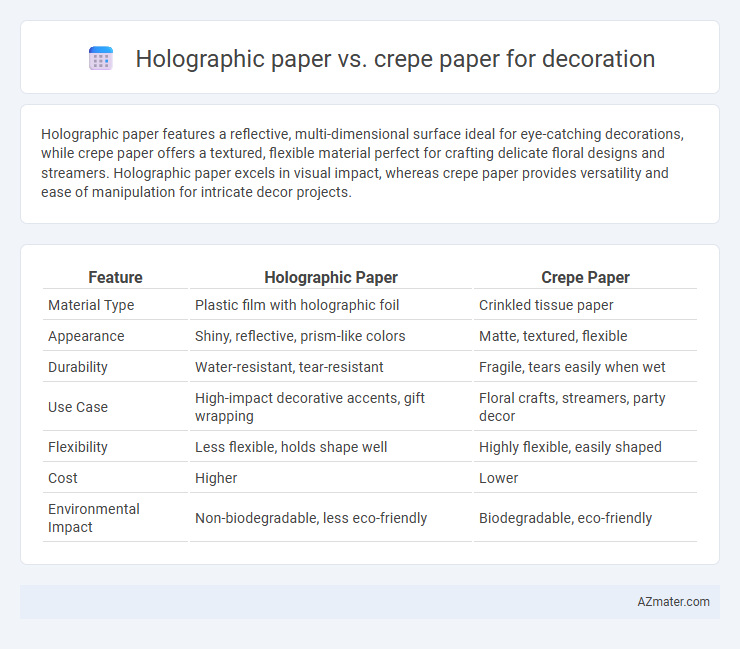Holographic paper features a reflective, multi-dimensional surface ideal for eye-catching decorations, while crepe paper offers a textured, flexible material perfect for crafting delicate floral designs and streamers. Holographic paper excels in visual impact, whereas crepe paper provides versatility and ease of manipulation for intricate decor projects.
Table of Comparison
| Feature | Holographic Paper | Crepe Paper |
|---|---|---|
| Material Type | Plastic film with holographic foil | Crinkled tissue paper |
| Appearance | Shiny, reflective, prism-like colors | Matte, textured, flexible |
| Durability | Water-resistant, tear-resistant | Fragile, tears easily when wet |
| Use Case | High-impact decorative accents, gift wrapping | Floral crafts, streamers, party decor |
| Flexibility | Less flexible, holds shape well | Highly flexible, easily shaped |
| Cost | Higher | Lower |
| Environmental Impact | Non-biodegradable, less eco-friendly | Biodegradable, eco-friendly |
Introduction to Decorative Papers
Holographic paper features a shiny, reflective surface that creates dynamic light effects, making it ideal for eye-catching decorations and event embellishments. Crepe paper offers a textured, crinkled finish and flexibility that allows easy manipulation for crafting flowers, garlands, and other decorative shapes. Both types serve unique purposes in decoration, with holographic paper enhancing visual impact and crepe paper enabling detailed, tactile designs.
What is Holographic Paper?
Holographic paper is a decorative material featuring a shiny, iridescent surface that reflects light to create a rainbow-like hologram effect, making it ideal for eye-catching decorations and crafts. Unlike crepe paper, which is textured and flexible, holographic paper is typically smooth and less malleable but offers a vibrant, reflective finish that enhances visual appeal. Its unique light-reflecting properties make it popular for party decorations, gift wrapping, and artistic projects requiring a futuristic or dazzling look.
What is Crepe Paper?
Crepe paper is a textured, crinkled paper commonly used in decorations due to its flexibility and ability to hold shapes such as flowers and ruffles. Unlike holographic paper, which features a shiny, reflective surface ideal for eye-catching accents, crepe paper offers a matte finish and vibrant colors that provide a soft, natural look. Its cost-effectiveness and ease of manipulation make crepe paper a popular choice for crafting detailed decorations and party embellishments.
Visual Appeal: Holographic vs Crepe Paper
Holographic paper offers a vibrant, shiny surface with shifting colors that capture light and create a dynamic, eye-catching effect ideal for modern and festive decorations. Crepe paper provides a matte, textured finish with rich, solid colors, lending a classic, elegant look suitable for soft, delicate designs and floral crafts. The choice between holographic and crepe paper depends on the desired visual impact--striking sparkle versus subtle texture.
Texture and Material Differences
Holographic paper features a smooth, reflective surface with a metallic sheen that enhances light play and visual depth, making it ideal for dazzling decorative effects. Crepe paper offers a textured, crinkled surface made from tightly crimped tissue, providing flexibility and volume perfect for crafting intricate floral designs and layered decorations. The material composition of holographic paper is typically plastic-based for durability and shine, whereas crepe paper is cellulose-based, giving it a lightweight, pliable quality suitable for varied crafting applications.
Durability for Decorations
Holographic paper offers high durability for decorations due to its sturdy, coated surface that resists tearing and fading, making it ideal for long-lasting displays. Crepe paper, while popular for its flexibility and texture, is less durable as it can easily tear or wrinkle and is more susceptible to moisture damage. For decorations requiring extended use or outdoor exposure, holographic paper provides a more resilient and visually striking option.
Versatility in Decoration Projects
Holographic paper offers vibrant, reflective qualities ideal for eye-catching highlights in decoration projects, making it a popular choice for party decorations, gift wrapping, and craft accents. Crepe paper provides exceptional flexibility and texture, suitable for creating detailed floral designs, streamers, and lightweight structures, enhancing dimensionality in decorations. The versatility in decoration projects depends on the desired effect: holographic paper excels in adding shimmer and brightness, while crepe paper allows for sculptural and textured elements.
Ease of Use and Crafting
Holographic paper offers a smooth texture that is easy to cut and shape, making it ideal for intricate decorative designs and quick crafting projects. Crepe paper is flexible and stretchable, allowing for easy manipulation and layering, which is perfect for creating dimensional floral decorations. Both materials provide versatility, but holographic paper requires careful handling to avoid creasing, while crepe paper's durability withstands more bending and twisting during crafting.
Cost Comparison: Holographic vs Crepe Paper
Holographic paper generally costs more than crepe paper due to its specialized manufacturing process and reflective surface technology. Crepe paper remains a budget-friendly option for decorations, offering flexibility and ease of use at a significantly lower price point. For large-scale projects, the cost difference can become substantial, making crepe paper ideal for cost-conscious decorators.
Best Uses for Each Paper Type
Holographic paper is ideal for eye-catching decorations such as gift wrapping, party banners, and festive crafts due to its reflective, shimmering surface that enhances visual appeal. Crepe paper is best suited for creating textured paper flowers, streamers, and backdrop decorations, offering flexibility and a matte finish that can be easily manipulated into various shapes. Choosing between holographic and crepe paper depends on whether the project prioritizes vibrant shine or tactile texture for decorative impact.

Infographic: Holographic paper vs Crepe paper for Decoration
 azmater.com
azmater.com